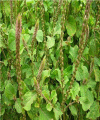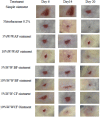Investigation of Wound Healing and Anti-Inflammatory Activities of Solvent Fractions of 80% Methanol Leaf Extract of Achyranthes aspera L. (Amaranthaceae) in Rats
- PMID: 33981155
- PMCID: PMC8109023
- DOI: 10.2147/JIR.S298244
Investigation of Wound Healing and Anti-Inflammatory Activities of Solvent Fractions of 80% Methanol Leaf Extract of Achyranthes aspera L. (Amaranthaceae) in Rats
Retraction in
-
Investigation of Wound Healing and Anti-Inflammatory Activities of Solvent Fractions of 80% Methanol Leaf Extract of Achyranthes Aspera L. (Amaranthaceae) in Rats [Retraction].J Inflamm Res. 2024 Dec 13;17:11055-11056. doi: 10.2147/JIR.S511569. eCollection 2024. J Inflamm Res. 2024. PMID: 39697793 Free PMC article.
Abstract
Introduction: The various fractions of leaves of Achyranthes aspera L. (A. aspera) have not yet been explored scientifically for in-vivo wound healing and anti-inflammatory activities. The objective of this study was, therefore, to evaluate in-vivo wound healing and anti-inflammatory activities of solvent fractions of 80% methanol leaf extract of A. aspera in rats.
Methods: The 80% methanol leaf extract of A. aspera was fractionated with chloroform, n-butanol and water. Wound healing and anti-inflammatory activities were evaluated using excision and incision wound models, rat paw edema and cotton pellet-induced granuloma models, respectively. For wound healing activity, fractions were evaluated at 5 and 10% ointments. The positive control groups were treated with nitrofurazone 0.2% ointment. Simple ointment treated for excision wound model and untreated for incision wound model rats were assigned as negative controls. For anti-inflammatory activity, fractions were evaluated at 100, 200 and 400mg/kg. Positive control groups were treated with indomethacin 10mg/kg for both rat paw edema and cotton pellet-induced granuloma models. The 2% Tween 80 treated rats were assigned as negative controls for both anti-inflammatory activity models. All groups comprised of 6 rats and treatment administrations were made topically and orally for evaluation of wound healing and anti-inflammatory activities.
Results: The 10% w/w chloroform fraction ointment revealed a high percentage of wound contraction and reduced period of epithelialization (p <0.01). Chloroform fraction was also found to be the most active fraction, which demonstrated the maximum percentage inhibition of edema (52.50%; p <0.01) and transudative and proliferative component of chronic inflammation (37.52 and 52.81%; p <0.01), which was comparable to indomethacin.
Conclusion: Data obtained from this study collectively indicated that a chloroform fraction of 80% methanol leaf extract of A. aspera possessed significant wound healing and anti-inflammatory activities.
Keywords: Achyranthes aspera; carrageenan-induced paw edema; cotton pellet granuloma; wound healing.
© 2021 Mengie et al.
Conflict of interest statement
The authors reported no conflicts of interest in this work.
Figures
References
-
- Farahpour MR, Habibi M. Evaluation of the wound healing activity of an ethanolic extract of Ceylon cinnamon in mice. Vet Med (Praha). 2012;57(1):53–57. doi:10.17221/4972-VETMED - DOI
-
- Garg P, Sardana S. Pharmacological and therapeutic effects of ocimum sanctum. Eur J Pharm Med Res. 2016;3(8):637–640.
Publication types
LinkOut - more resources
Full Text Sources



